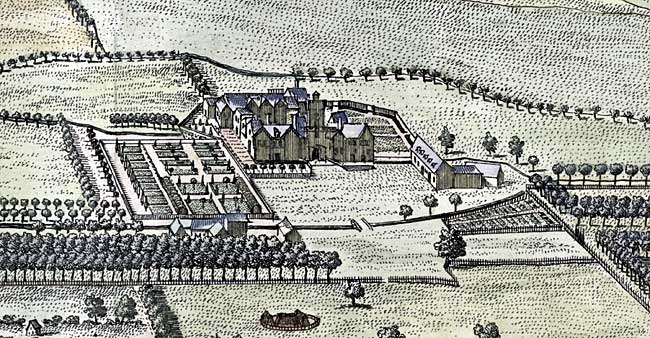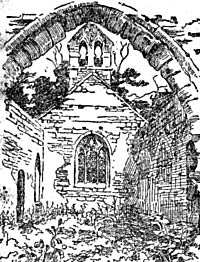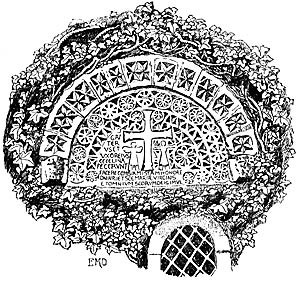< Previous | Contents | Next >
Great Days Gone

Haughton Hall in 1709.
HAUGHTON. So secluded is this place that it is hard to imagine the great days when the Longvilliers, the Manlovels, and the Stanhopes were its lords; or the 16th century days of pomp and splendour when it came into the family of Holles, who had found wealth in London bakehouses and honour at the Mansion House, for one was Lord Mayor. They rebuilt the old homestead of the Stanhopes in splendid style, and made it one of the most famous houses of the county, known far and wide for its hospitality. They even kept a company of players. Denzil Holles, most famous son of his family, the statesman who held down the Speaker in the Chair while the Commons passed the Resolutions against the Crown, was born here in 1599. He was one of the Five Members Charles tried to arrest. His grand home fell into decay when the family, then Earls of Clare, made Welbeck their home; its only remains are in the moat and the stone foundations of the buildings of a farmhouse on its site.

Sketch of the ruins of Haughton Chapel in 1907.
A walk across the fields, in company with the little tree-shaded River Maun, brings us to the far; and just beyond it, on the brink of the river, is the roofless ruin of a Norman chapel, with mighty trees in its mantle of beech and yew, chestnut and sycamore. It saw Haughton's great days come and go.
Open to wind and sun and rain, and overgrown with weeds, it has still the old bellcot, herringbone masonry in the walls, a Norman doorway adorned all round with zigzag and cable, and the battered bowl of a Norman font. The traceried medieval windows are for the most part blocked, and in the nave wall are the short pillars and great capitals of an arcade which led to a vanished aisle. A fine pointed arch leads to the chancel, which has a tiny piscina and an image bracket. From the close of the 12th century comes an arch to the small north chapel, which has lost its east wall. A broken floorstone carved with a cross lies in the nave. One of three memorials to the Stanhopes is the broken figure of a woman in a long gown, her features worn, and her hands still at prayer; the others are gravestones, each showing the upper part of a figure recessed in a quatrefoil.
It is said that Sir William Holles, who died in 1590, was buried here. He was known as the Good Lord of Haughton for his display of hospitality; no one was ever turned from his door.
From Norman England

The tympanum at Hawksworth church in the 1890s.
HAWKSWORTH. Two treasures in the little church bring us to this out-of-the-way village in the Vale of Belvoir. In a pretty setting is the low creepered manor house, shaded by giant chestnus trees, its orchard a riot of daffodils in spring. The house in a beautiful garden by the church was once the rectory. The church has an older story than its brick tower and its chancel made new would lead us to think, for built into an outside wall of the tower is a splendid Norman tympanum. Round it are roses and stars, in the middle is a cross, and beneath its arms are smaller crosses and figures of the two thieves. In tiny medallions over the arms of the big cross is a holy lamb and an archangel, and on one side is a Latin inscription saying that the church was built by Walter and Cecilina his wife, who lived eight centuries ago.
The other treasure is under the tower, of which the basement forms the porch. It is a fine stone nearly six feet high, richly carved with plaitwork and knotwork, and a cross with a head at each end. It has served as the lintel for a Norman doorway to which the tympanum once belonged. Looking out from the south wall of the nave are three old gargoyles of huge grotesque animals.
